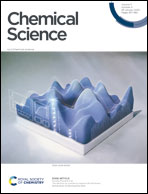Hollow zeolite microspheres as a nest for enzymes: a new route to hybrid heterogeneous catalysts†
Abstract
In the field of heterogeneous catalysis, the successful integration of enzymes and inorganic catalysts could pave the way to multifunctional materials which are able to perform advanced cascade reactions. However, such combination is not straightforward, for example in the case of zeolite catalysts for which enzyme immobilization is restricted to the external surface. Herein, this challenge is overcome by developing a new kind of hybrid catalyst based on hollow zeolite microspheres obtained by the aerosol-assisted assembly of zeolite nanocrystals. The latter spheres possess open entry-ways for enzymes, which are then loaded and cross-linked to form cross-linked enzyme aggregates (CLEAs), securing their entrapment. This controlled design allows the combination of all the decisive features of the zeolite with a high enzyme loading. A chemo-enzymatic reaction is demonstrated, where the structured zeolite material is used both as a nest for the enzyme and as an efficient inorganic catalyst. Glucose oxidase (GOx) ensures the in situ production of H2O2 subsequently utilized by the TS-1 zeolite to catalyze the epoxidation of allylic alcohol toward glycidol. The strategy can also be used to entrap other enzymes or combination of enzymes, as demonstrated here with combi-CLEAs of horseradish peroxidase (HRP) and glucose oxidase. We anticipate that this strategy will open up new perspectives, leveraging on the spray-drying (aerosol) technique to shape microparticles from various nano-building blocks and on the entrapment of biological macromolecules to obtain new multifunctional hybrid microstructures.



 Please wait while we load your content...
Please wait while we load your content...